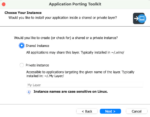
Docker for Mac and Docker for Windows are moving up in the world, and both are now out of beta, stable and ready for production.
Among the changes from the beta version is a native development environment using hypervisors built into each operating system, which means no more VirtualBox. Docker tools integration has been improved, and all that are needed to develop locally are now in the app.
Also, this release includes improved development flow, which means in-container debugging is supported with IDEs, allowing developers to iterate code with less effort, according to a Docker blog post. The enterprise network support that lets Docker for Mac and Windows work with VPNs, and all the new features are available in Docker 1.12.
With the stable release, Docker 1.12 includes a variety of new features, like built-in orchestration and end-to-end encryption.
QASymphony survey: Test-first methodologies improve software releases
QASymphony completed a survey of more than 200 software testers, and a key finding was that test-first methodologies have the potential to improve software releases.
According to the survey, 38% said they would shift to a test-first approach this year, and 25% of testing practitioners said it would happen within three years. Other testers said that their testing process was Scrum or Kanban requirements-driven before turning to a test-first methodology. Twenty-one percent said that their approach was iterative requirements-driven, and 18% even said that they still are waterfall requirements-driven.
“In analyzing the results of our survey, it seems clear that test-first methods are really taking hold, even as companies experiment to find the best route forward for them,” says Kevin Dunne, Vice President of Strategy at QASymphony. “When companies put testing at the front of the process, it provides the time and attention to quality that is often lacking in a traditional development process. For teams that are constantly squeezing test cycles in an effort to get software out the door on time, test-first approaches might provide the change of pace needed to drive the high-quality releases they desire.”
The full 2016 State of Test-First Methodology Report can be found here.
Aurelia 1.0 release
Aurelia, a platform for building apps on open web technologies, announced its official release this week.
Aurelia embraces web standards of ES 2015+, web components, and the modern DOM. It allows developers to stay out of their JavaScript code so they can focus on building their apps. Developers can create business and other kinds of apps on top of this platform.
Aurelia is available through outlets such as Aurelia CLI, JSPM, NPM, Webpack and more.
Microsoft announces additional layoffs
In order to meet productivity goals and increase communication across devices and platforms, Microsoft announced that it is planning to eliminate approximately 2,850 roles globally, which will be reduced by the end of fiscal year 2017.
As of June 30, Microsoft employed approximately 114,000 people on a full-time basis, with 63,000 in the U.S. and 51,000 internationally. It was in 2015 where Microsoft approved a restructuring plan that eliminated approximately 7,400 positions in fiscal year 2016, primarily its phone hardware business. As a way to continue to restructure across its smartphone hardware business and global sale, Microsoft will eliminate another 2,850 jobs globally, including the 1,850 positions that were scheduled to be eliminated in May 2016, according to Microsoft’s annual report.
HPE adds security extension to stop cyber attacks
Hewlett Packard Enterprise announced a new offering called HPE Privileged Account Management (PAM) Service, an extension to the HPE Managed Security Services portfolio. This offering was created to help customers mitigate the risk with privileged accounts, so they can stop cyberattacks and enforce consistent application of security policies.
According to the company, 80% of all targeted attacks exploited privileged accounts during an attack process, and often these attacks take over an IT infrastructure. HPE PAM Service will help organizations address their security challenges, such as advanced targeted attacks, insider threats, malware targeted at privileged accounts and the outsourcing of sensitive information.
Benefits of the new HPE PAM Service include protection against cyber attacks, visibility into systems and infrastructure, and compliance support. The HPE PAM Service is available to customers as part of the HPE Managed Security Services portf






